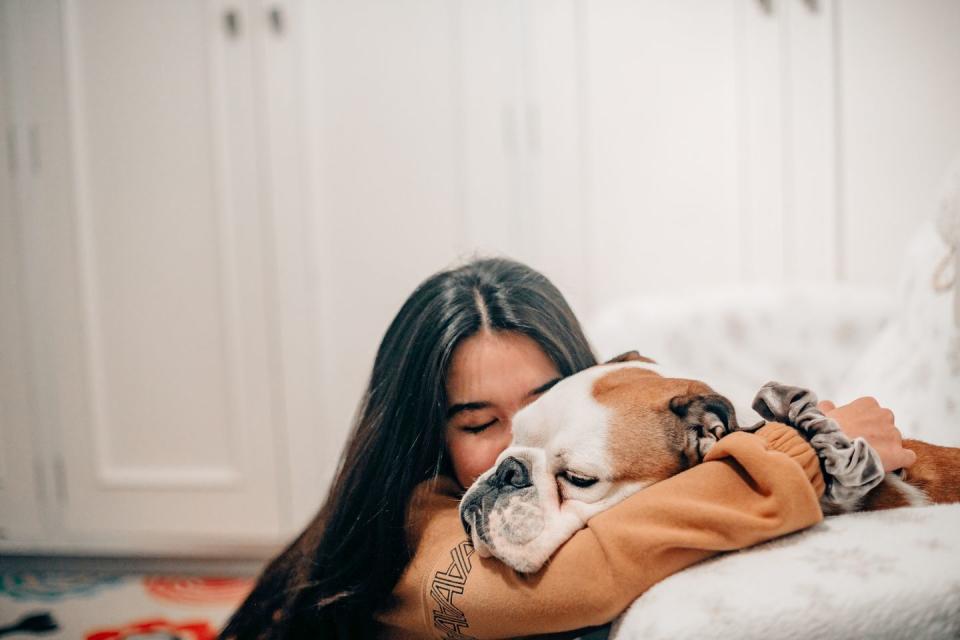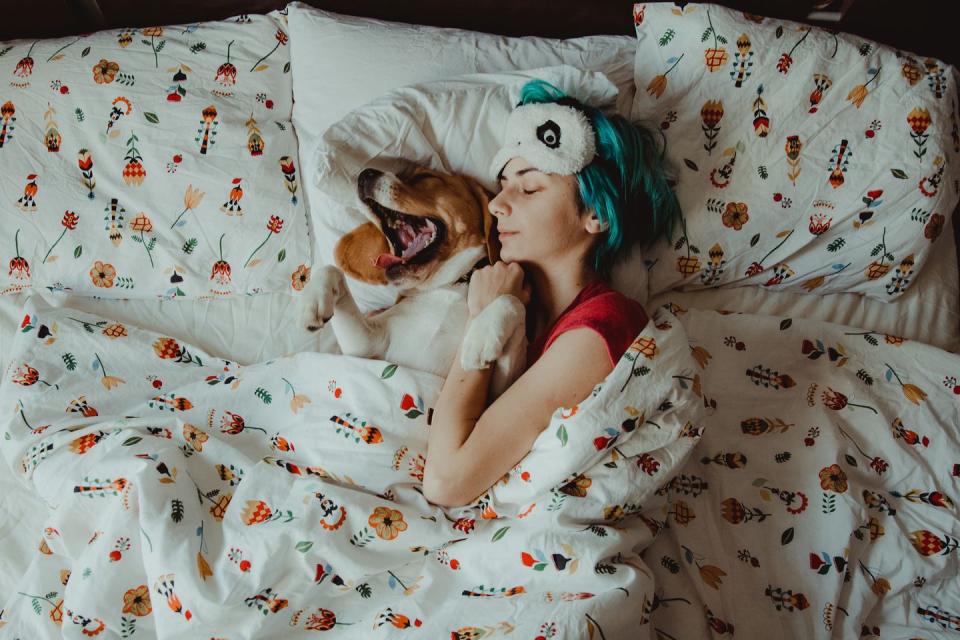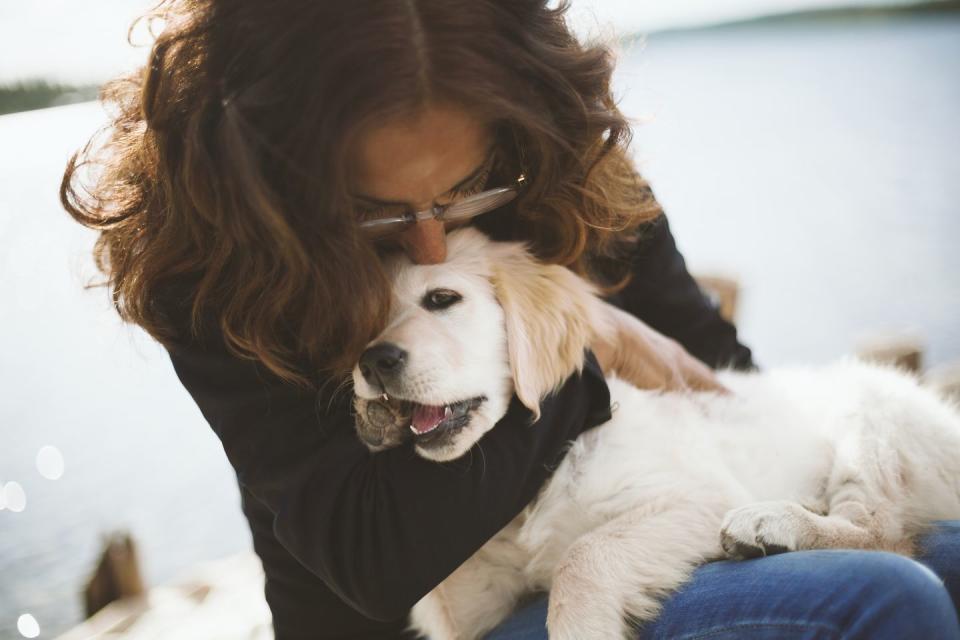How to Adopt a Dog & Gain a Forever Friend
“Hearst Magazines and Verizon Media may earn commission or revenue on some items through the links below.”
When a person decides it's time to adopt a dog, they usually fall into one of two categories: They become so excited about the prospect of never-ending puppy snuggles they assume the entire process will be a cakewalk, or they're so nervous and anxious they descend down a rabbit hole of Google searches and read a plethora of "how to adopt a pet" guides.
In reality, adopting a dog is a little bit of both: You're excited, and scared, and nervous, and can't wait to have a furry friend to cuddle and play with. And due to the COVID-19 pandemic, more and more people are adopting pets and expanding their families, one little fluff at a time. While things are particularly stressful these days, taking the time to properly research the ups and downs of adopting a dog can help you feel prepared to welcome a new pet into the fold.
So whether you’re worried about finding the right dog, figuring out how to adopt a dog, or making sure your new furry family member adjusts to the intricacies of your home, below are some good tips, pointers, and reminders to go over before signing those adoption papers and welcoming your new four-legged-friend into the fold. And even if this isn’t your first time adopting, these expert-approved recommendations are sure to come in handy now.

Research different types of dogs beforehand.
Before you ever set foot in a shelter (virtually or otherwise!) it’s a good idea to do a little research into what type of dog will do best given your lifestyle and family, Dr. Shelly Zacharias, DVM, MS, VPM, BCMAS and Vice President at Gallant, a biotech company that develops regenerative therapies using a pet’s natural biology, tells Woman's Day.
“Things to think about include your energy level, do you stay inside and watch movies a lot or are you going on hikes and to parks often? Do you share your home with children, elderly, or other pets? Pets are a very long-term commitment (or should be) so think about what your future holds," she says. "For example, are you moving, getting married, retiring, having kids? How tolerant are you of things such as shedding, slobber, etc? These are just a few of the things to think about to make sure your pet fits in well with you and your life."
Think about your lifestyle and family needs.
Dr. Annie Valuska, Ph.D., senior feeding behavior expert at Purina, agrees that research is the most important part of adopting. She also agreed with Dr. Zacharias about the next most important step — thinking about what type of dogs would mesh with your lifestyle.
“By exploring various breeds, their energy levels, grooming needs and other factors, potential dog owners can ensure they bring home a dog that seamlessly fits into their lives,” Dr. Valuska says.
Get rid of any preconceived misconceptions.
There are a slew of misconceptions about adopting dogs that prevent people from choosing a pet responsibly. Before heading to the shelter, it’s worth debunking some of those misconceptions — especially, as Dr. Zacharias points out, when it comes to adult dogs.
“Some people believe that they will be misbehaved, they are too old to house train, they are already who they are, they won’t bond with the family, we don’t know their history, they are dirty and smell bad, etc. I cannot tell you how common, sad, and frustrating it is to hear these thoughts when it comes to adopting,” Dr. Zacharias says. “I also cannot stress how untrue these assumptions often are. Dogs in an unstable environment such as a shelter, rescue or foster home cannot show who they truly are - we all act very differently under stressful times of unrest…yes? Realistically, any dog, any breed, of any age, coming into your home will need training in order to be a good family member.”
Start a pet-specific savings account.
Another thing to consider when you’re thinking about adopting a dog is the cost associated with a dog. The adoption fee itself is one thing, but there are also all the other costs associated with having a pet. This includes boarding fees, food fees, vet fees, and more.
“Start a savings account only for pet-related expenses before getting a dog, so there is money to properly care for him/her and in case an emergency happens." Zacharias suggests. "A pet brings a lot of joy, responsibility, and a big financial responsibility which should be planned for as with any other financial decision. Too often I see clients spend thousands on a pet from a pet store then they do not want to or cannot afford to pay basic care for such as vaccines and heartworm prevention, not to mention unexpected illness. This is a consideration that should be at the top of the planning list."
In case you weren’t sure just how much you have to save, Jordan Karcher, founder of Grounds & Hounds Coffee Co, tells Woman's Day that, "on average, you could expect to spend between $1,000 and $1,200 in the first year alone." Many of these costs are not recurring, i.e. one-time spaying or neutering procedures, a collar and leash set, a license, and microchipping. But there are also the annual costs to consider as well, including pet food, toys, and other treats.
"We suggest setting aside an emergency fund of $1,000 to $2,000 as you never know when you’ll have that unexpected vet visit," Karsher says. "No one wants to be in a situation where you have to choose between the health of your pet and paying for your rent [or] mortgage that month. It can also prove effective to budget out your finances month to month to ensure you really can cover the additional cost of a pet before adopting."

Then stock up on pet supplies.
If you’ve decided that adopting a dog makes sense for you and your family, it’s time to prep to bring home your new best friend.
“Be sure and stock up on all the essentials you need, from a crate and dog bed to the correct food formula based on your new pet’s life stage: puppy, adult or senior. A recent Purina survey found that while most puppy owners know dogs under a year old are considered puppies, the majority don’t realize that breed size determines how long their dog is considered a puppy and ultimately how long they need to feed puppy food; for example, some large breed dogs may need to be on puppy food for up to two years! Be sure to factor in your dog’s breed size (i.e., the size she’ll be when fully grown) when stocking up on food,” Dr. Valuska suggests.
If you’re not sure what type of dog you’ll be adopting until the day you adopt them, it’s worth shopping for things like specific food, etc. directly after the adoption.
Do some home prep before pup arrives.
Steve Ball, CEO of Zesty Paws, a pet supplement and grooming products company, tells Woman's Day that another important step before adopting a dog is to assess and prepare your home.
“You must prepare your home before bringing in your new furry friend. Make sure any valuable or breakable items are out of reach,” Ball says. “If the dog isn’t potty trained, remove any rugs (if applicable) until they are trained to avoid any damage.”
Look for the pet you have chemistry with.
If you do physically visit a shelter, Ball suggests making sure you bring everyone who will be around the dog on a daily basis and to look for chemistry between everyone and the dog (if it is safe and you can practice social distancing, of course). If you're meeting your potential future pup via Skype or another online service, make sure you still include the people who will be around the pup frequently — just like Zoom birthday parties, weddings, and graduations, you can absolutely pick the perfect pup online.
“Pay attention to the dogs’ body language and energy level to ensure they match yours,” Ball says. “It’s OK for dogs to feel shy or skittish at first when brought out of their kennel to meet you.”
Be prepared to work through an adjustment period.
Whether you adopt a puppy or an adult dog, there’s going to be an adjustment period where your new pet gets used to your family and your home, and visa versa. Be sure to take some time off from working at home (or, if you're an essential worker, working outside the home) to make sure you’re there as your new family member adjusts to its surroundings.
“After the adoption, take some time off to bond with your new friend! It’s normal for them to have upset tummies and accidents, as they’re getting used to a new environment,” Ball says.
Consider investing in training classes.
Once you’ve assessed your lifestyle and chosen a dog that makes sense for you, it’s time to bring the pup home. This is often the fun part, but is sometimes less stressful if you consider signing up for training sessions or classes.
“Bond with your pet first and foremost to form a loving and trusting relationship. Start going to training classes so everyone in the new relationship knows where they stand,” Dr. Zacharias suggests.
Involve the whole family in the process.
From beginning to end, the adoption process should be something that involves each and every member of your family, Dr. Amanda Landis-Hanna, DVM, senior manager of veterinary outreach at PetSmart Charities.
“Involve the whole family in the adoption conversation. Will kids be responsible for feeding the new 'roommate'? Do your current pets (if any) tolerate other animals OK? The new dog is a big change for everyone, so allow everyone to weigh in, and suggest how they would like to help care for him/her,” Landis-Hanna says.

Schedule regular vet appointments (if you can).
As soon as you get your new dog, you’re going to want to set up regular vet appointments (if this is possible and you can do so while continuing to practice social distancing). This way you can make sure they are their healthiest and you’ll know have a go-to doctor should the animal ever need any medical attention.
“Establish a regular provider for vaccinations, check-ups and grooming needs. You will be responsible for all care of your pet,” Landis-Hanna says. “Consider financial planning options, including pet insurance, wellness plans, or payment plans; the longer you wait the more likely your pet is to have a pre-existing condition.”
Be prepared to continuously assess your dog's nutrition.
Every dog needs to eat something slightly different, based on their specific medical issues, size, and age. Landis-Hanna suggests checking your dog’s diet right away and getting things on the right track.
“Consult your veterinarian on any changes to your pet’s food, and always accurately measure your pet’s food vs. eyeballing it," she says.
Choose a reliable emergency contact.
Finally, Landis-Hanna says it’s an important step to establish an emergency contact should your pet ever need another human to take care of it for whatever reason.
“Select an emergency hospital appropriate for your species of pet, and put the name, phone number and address where it is easily found, and share it with your pet’s emergency contact,” she explains.
You Might Also Like


